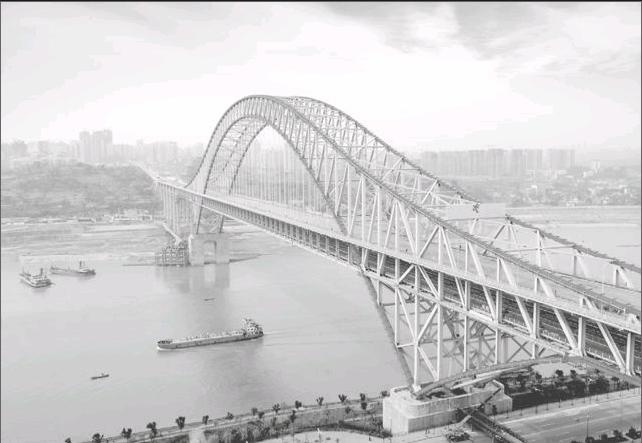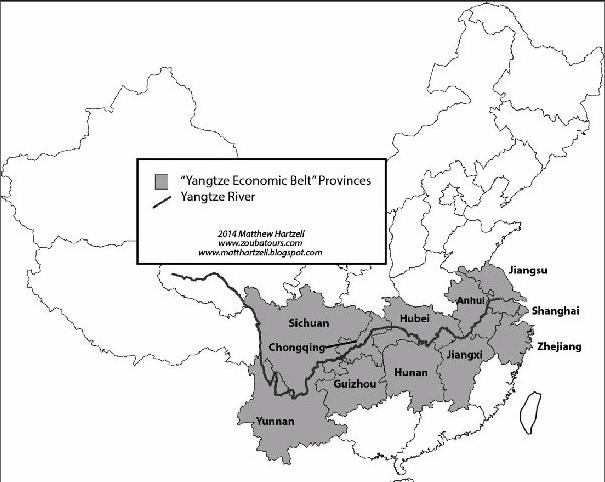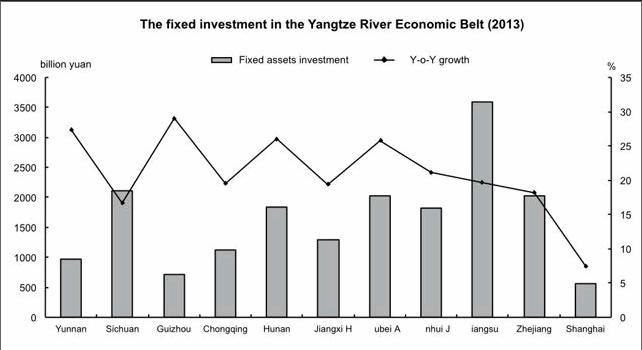Yangtze River Economic Belt Aims to Unify the Market
2015-04-23



On October 25, 2014, the financial leaders of nine provinces and two municipalities along the Yangtze River, which are Shanghai, Jiangsu, Zhejiang, Anhui, Jiangxi, Hubei, Hunan, Chongqing, Sichuan, Guizhou and Yunan, gathered together in Wuhan, Hubei.
On that day, the first Financial Forum of Yangtze River Economic Belt was held in Wuhan. Regional interaction and cooperation, regional financial center and the unified market system of Yangtze River Economic Belt became the key words most mentioned in this forum.
Since the issuance of The Guiding Opinions of Promoting the Development of Yangtze River Economic Belt with Golden Water courses (hereafter Opinions) by Chinas State Council in September 2014, there are more and more similar joint conferences, showing the increasingly stronger will of all places to build a unified market.
To form a united market and to break the administrative barrier and local protectionism are the keys to unlocking the“dividends of reform”.
Peng Zhimin, President of the Yangtze River Economic Research Institution at Hubei Provincial Academy of Social Sciences, says that the grand market in the Yangtze River Economic Belt is far from being unified because of the great administrative power. In the middle reach of Yangtze River particularly, the less developed economy raised local governmentsneed to set up thresholds for outsiders in consideration of protecting local enterprises, taxation and employment. This leads to the segmentation of the market.
In Peng Zhimins opinion, the government should intervene in the market less frequently. The provinces and municipalities should begin their cooperation with the sectors less influential for local employment, taxation and key enterprises and gradually promote the reform.
Traffic Integration Taking the Lead
The Yangtze River is more than 6,300 kilometers long in total and provides 36.5% of the water resources, 48% of the exploitable hydroelectric resources and 52.5% of the inland river cruising course. It is a “golden water course” that connects the eastern and western parts of China. In 2013, the shipment volume in the main line of Yangtze River reaches 1.92 billion tons, taking the No. 1 position in all inland rivers for nine straight years. it is closely followed by Mississippi River in the United States and Rhine in Europe.
However, this golden water course is facing the problems of insufficient traffic volume, ill-functioned network and less developed comprehensive traffic hub, which further limits the further development of the shipping industry in this area.
According to a director of the administrative department of the water course of Yangtze River, in the past, the investment made by the government into the water course of Yangtze Rover and water transportation do not match the status of Yangtze River in the shipping industry of China. He also points out that the water course of Yangtze River faces the problem of “caring about the construction while ignoring the management and maintenance”. There are not feasible laws and regulations about the water course to keep the excessive and illegal exploitation in and along Yangtze River at bay. The “excessive draught”, which refers to the shipping volume beyond the capacity of the water course, is quite common in recent years. The ill-designed bridges and dams sometimes stop or even cut off the water course. In addition, the task of maintaining the water course is getting tougher and tougher, pushing up the cost in which the gap is getting ever bigger.
In the Opinions, the task of “improving the functions of golden water course” gives priority to the enhancement of shipping capacity of the water course and the improvement of navigation conditions of tributaries. The Opinions also puts forward the goal of
improving the shipping volume of Yangtze River Economic Belt from 17.9 billion tons in 2013 to 27 billion tons in 2020, and increasing the passenger capacity from 18.1 billion in 2013 to 31 billion by then.
Also in October 2014, Chinas Ministry of Traffic and Transportation held a Promotional Conference of Traffic and Transportation in the Yangtze River Economic Belt. In the conference, Yang Chuantang, Minister of Traffic and Transportation, pointed out the necessity of enhancing the governance of water course of Yangtze Rivers main line and building an obstacle-less water course network with smooth accesses to seas and tributaries. In addition, the pivotal role of ports should be enhanced, the models of ships should be standardized fort he great development of modern shipping industry; and the modern shipping service industry must be enhanced.
Apart from shipping industry, the Ministry of Traffic and Transportation also lists the goal of building a comprehensive traffic system consisting of “one river, two west-east high-speed railways and five south-north high-speed railways. The principle of appropriate advance should be followed in the construction of a railway network featuring high speed and capacity, the formation of high-class expressway network, the promotion of aviation network, the acceleration in the comprehensive traffic hub and the building of the inter-city traffic network.
Some provinces and municipalities are exploring in the field of integrated traffic system. In the past, there were 18 dead end highways around Hubei, disabling the formation of the expressway network of this province and encumbering the traffic and transportation of the provinces in the middle reach of Yangtze River. In recent years, with the advance of the urban agglomeration in the middle reach of Yangtze River, 15 highways have been connected or are being connected. The other three are put into the plan too.
Cooperation and Competition in the Middle Reach
The Opinions covers the requirement of fostering the urban agglomeration in the middle reach of Yangtze River and enhancing the urban functions of Wuhan, Changsha and Nanchang to promote the three cities in the integration of their resources, division of industrial sectors and interaction among cities. All these serve the goal of building the urban agglomeration into the resource-economical and environment-friendly exemplary community that could lead the rise of Central China.
This is the first time that the Chinese central government made a definition of the “triangle in Central China”. Prior to the national strategies, Hunan, Hubei and Jiangxi have already initiated the cooperation in the infrastructure, traffic and tourism.
Early in February 2012, Hunan, Hubei and Jiangxi convened a consulting meeting about the urban agglomeration in the middle reach of Yangtze River in Wuhan, in which the governmental leaders of the three provinces talked about the construction of urban agglomeration in the middle reach of Yangtze River and the economic growth pole of the “triangle in Central China”.
According to the cooperative agreement reached by the three provinces, the “triangle in Central China” is going to take Wuhan, Changsha and Nanchang – the capital cities of the three provinces – as the core and build an urban agglomeration consisting of 27 prefecture-level cities along the Yangtze River, around Dongting Lake and Boyang Lake. The cities in the area of “one river and two cities” are to cooperate with each other to form a cross-province urban agglomeration with economic unity.
According to Peng Zhimin, the governmental leaders of the three provinces attached great importance to this case. The governmental departments and the governments of cities, counties and towns also made extensive negotiations which lead to the closing of a series of agreements. For example, the tourism departments of the three provinces are trying to build a tourism route that connects the three famous ancient buildings inside them. They also issue the couple ticket that allows tourists to visit scenic spots in the three provinces.
Starting from 2014, the three provinces began to extend their cooperation scope. They have made tryouts in the talent and labor force information platform, trademark protection, prevention of consumers rights, mutual recognition of medial insurances and support for cross-region development of trade enterprises.
“Generally speaking, there is still a long way to go to pro- mote the integration of the market and build a unified market,”says Peng Zhimin. It is especially so when it comes to the production factors, capital and high-end talents because they are scarce resources for the three provinces. They all hope to set up a platform that can benefit and drive the development of surrounding areas. In another word, they all want the financial center, trade center, logistics center and shipping center to be built in their own place.
In addition, the cities in the “triangle in Central China” are facing a common problem – the severe homogenization of the industrial sectors. The automobile industry is the pillar industry of Central China; Wuhan and Changsha give priority to the development of digital information; and biomedicine takes a large part of the GDP of Changsha and Nanchang. These factors cause these cities to compete rather than cooperate with each other in the development of their advantageous projects and contending for the capital and projects moved from East China.
Avoid the “Autistic Thinking”
The problem that haunts the cities in Central China also finds its way to vex the other provinces and municipalities in the Yangtze River Economic Belt.
Yi Cheng, deputy director of the Research Institute of the Peoples Bank of China, points out that it is necessary to enhance the cooperation between financial institutions and governments and eradicate the obstacles of administrative division for the financial industry while maintaining the financial stability.
According to Yi Cheng, the experiences from the Pearl River Delta and the situation in Hubei, Jiangxi and Hunan reveal that the financial cooperation among cities and urban agglomerations can be made in several aspects: building the financial cooperation system, promoting the regional financial cooperation and the vertical and horizontal linkage, setting up the innovation-oriented financial policy system, providing stronger financial and funding support, building a multileveled system of financial institutions to gradually realize the differentiation in the positioning of financial institutions for the reasonable division of tasks, and finally, forming a diversified financial industry covering commercial banks, securities, insurance, venturing investment and industrial investment funds.
Qin Zunwen, Vice President of the Hubei Provincial Academy of Social Sciences, points out that the construction of Yangtze River Economic Belt is the driving force and life that requires the total breakdown of administrative division-based shackle, industrial monopoly, local protectionism and urbanrural differentiations. It is necessary to set up the idea and prin ciple of “same treatment in the same area for equity and unity” in the area along the Yangtze River.
Peng Zhimin gives out his suggestion: the construction of a united market in the Yangtze River Economic Belt entails the full exertion of the deciding role of market in the allocation of resources and reduction of the governmental interference in the market. Local authorities of all levels must admit and accept the result chosen by the market while providing effective protection. These cities or provinces that cannot be made the center in a short while could create and improve conditions for the development into the hubs or important nodes. They can choose the sectors that have less influence over local employment, taxation and key enterprises as the breach points before deepening the cooperation.
Rick Niu, board chairman of U.S.-based C.V. Starr believes that the municipalities and provinces need to avoid the “autistic thinking” to develop the Yangtze River Economic Belt and build a united market. They cannot say “I am now in this city or province and I only care about its development.”
杂志排行
中国经贸聚焦·英文版的其它文章
- Towards a Comprehensive Understanding of New Normal
- S&P: Real estate downturn may pose biggest risk to Chinese banking sector
- China to roll out policies to support robotic and intelligent equipment manufacturing in H1 2015
- The Threat of Deflation
- CPI Trend from Nov.2013 to Nov.2014
- Latest Public Official Changes in China
